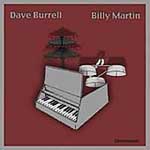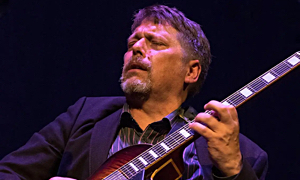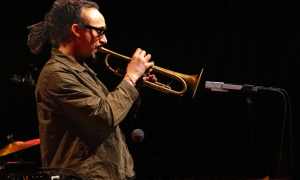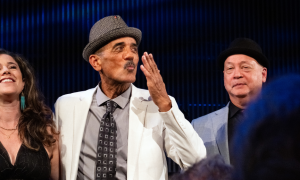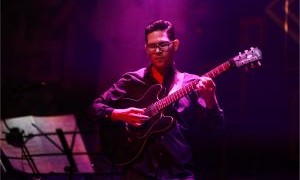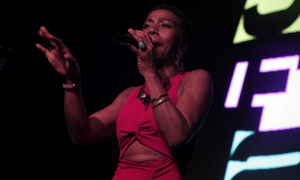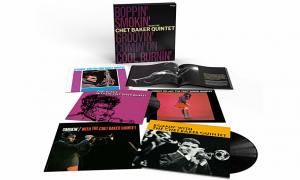Home » Jazz Articles » Live Review » Punktfest 06 - Kristiansand, Norway - Day Three, August 26, 2006
Punktfest 06 - Kristiansand, Norway - Day Three, August 26, 2006
The final day of Punktfest got off to a somewhat subdued start, but that doesn't mean the performances weren't at the same high level as the previous two days. Day three also had two of the festival's most memorable performances—and considering how memorable the entire festival has been, that's a definite achievement.
Chapter Index
- Phonophani & Marius Watz
- Erik Honoré & Elsewhere
- Bernhard Gunter
- Nils Petter Molvaer & Helge Sten
- Sidsel Endresen & Jan Bang
- Pal "DJ Strangefruit" Nyhus, Knut Saevik & Peter Barden
- Arve Henriksen
- Honoré/Baden/Aarset/Molvaer/Boine/Augland
Phonophani & Marius Watz
Phonophani's performance, the first in the main theater, was a curious combination of ambient textures, minimalism and understated noise improv. For this special performance Espen Sommer Eide (who is Phonophani) collaborated with visual artist Marius Watz, bringing yet another innovative collaborative concept to a festival that seems to define new ones at almost every show. More than simply a visual presentation, Watz was an active participant, couched in darkness on stage along with Eide. Like all good improv, there were times where Watz's evolving images drove the music, other times where the music drove the images, and many others where the two worked in perfect synchronicity.
Both artists had the requisite laptops that have appeared at almost every Punkt performance, but Eide also utilized a wind-driven synthesizer to create melodic snippets that sometimes formed a minimal rhythmic pulse over which many textures were layered. Phoniphani's music could be quite dense at times, yet as cacophonic as it sometimes became, it could possess a strangely beautiful and hypnotic quality. There were assorted electronic squawks and burbles, but there were also rich washes of sound which ranged from eminently appealing to jaggedly sharp-edged.
Watching the images respond to the music, often slowing down or picking up right along the soundscapes, was a unique experience—as was watching the Eide do the same in reverse. And while the set ebbed and flowed in a continuous fashion, it had specific and logical breakpoints, most often revolving around Watz's shifts from three-dimensional cubes which looked like something out of an Escher painting to long stems with colorful discs at the top that seemed to shrink and grow with the music and large, somewhat amorphous shapes in vivid greens.
With the artists on stage in near-darkness, the clear goal was to have the audience pay attention to the visuals and integrate them with what they were hearing. Rarely ever applying anything like conventional harmony, melody or rhythms, but bearing occasional earmarks of all three, the performance was yet another example of how technology can be used to create something new that demands its audience to dispense with preconceptions of what music should be.
Erik Honoré & Elsewhere
While Jan Bang has cropped up as a participant at more shows than one can count, his Punktfest partner, Erik Honoré, seems to work a little more behind the scenes, only on stage for some of the live remixes. But for the Alpha Room's first show of the day, he was featured with his group Elsewhere in an odd combination of folk tradition, technology and its own pop sensibility.
Along with Honoré, Elsewhere features singer Greta Aagre, whose voice at times recalled Maire Brennan from the Irish group Clannad. But Aagre also proved a flexible singer with a rich tone in her lower range, which worked well with music that required her to be delicate at times, powerful at others. Acoustic guitarist Jorgen Rief was a strong accompanist, fingerpicking intentionally during the more song-based sections, but equally capable of scratching strings, tapping the body and creating other unusual sounds that Honoré could sample and feed back to the trio.
If there's an underlying theme at Punktfest, it's that rules are made to be broken and musical styles are wide open to the application of contemporary sonic approaches. The trio's brief set began with Rief extracting all manner of odd sounds from his guitar, while Honoré sampled them, built loops and added his own washes of sound into something that was closer to free improv than song. Even when Aagre entered and things became more tuneful, there were still moments where the melodism would break down into freedom, only to return once more in a concerted way to the group's lyrical side.
Elsewhere's second tune had a more distinct pop vibe, but Honoré's deep bass sample, drum programming and live sampling of Aagre's voice made it pop music with its own flavor. And while some of Elsewhere's material more or less followed conventional pop/folk song form, there were times where the musicians dispensed with such conventions altogether and moved into the area of atmospherics. Perhaps best described as ambient folk, Elsewhere's performance demonstrated yet again that samplers and sound processors can be either cold technology, or—as has been the case time and again over the past three days— powerful tools to realize unequivocally new musical ends.
Bernhard Gunter
That fact is not lost on Bernhard Gunter. The earlier part of his career was focused on composition in the realms of Morton Feldman, Luigi Nono and Iannis Xenakis. But he's been focusing more on improvisation recently, and his performance in the main theater bore the sonic trademarks of some of his earlier works, but with a completely spontaneous aura.
 Seated on a cushion on the floor of the stage facing his rack of gear, Gunter made it clear that, like Phonophani, his intention was not to be a visual focus. With long silences sometimes separating a series of ticking pulses and subtle white noise, there was virtually no reference to melody in his meditative, almost spiritual music. Dark and deep tones sometimes emerged as his single improvised piece evolved, and one segment sounded like an altered acoustic guitar sample, but Gunter's music cannot and should not be over-analyzed. It demands, instead, to simply be experienced without necessarily searching for reference points—in other words, felt rather than heard. It's clear that this approach to sound and space resonates deeply with Gunter—and based on the action at the CD kiosk in the foyer after the show, his audience as well.
Seated on a cushion on the floor of the stage facing his rack of gear, Gunter made it clear that, like Phonophani, his intention was not to be a visual focus. With long silences sometimes separating a series of ticking pulses and subtle white noise, there was virtually no reference to melody in his meditative, almost spiritual music. Dark and deep tones sometimes emerged as his single improvised piece evolved, and one segment sounded like an altered acoustic guitar sample, but Gunter's music cannot and should not be over-analyzed. It demands, instead, to simply be experienced without necessarily searching for reference points—in other words, felt rather than heard. It's clear that this approach to sound and space resonates deeply with Gunter—and based on the action at the CD kiosk in the foyer after the show, his audience as well. Nils Petter Molvaer & Helge Sten
The next main theater show was an intriguing double bill with totally unpredictable end results. Trumpeter Nils Petter Molvaer teamed up with Helge Sten, one quarter of the free jazz/electronica/noise band Supersilent. But Sten—also known as Deathprod on his own projects—played guitar, rather than adopting his usual role as sonic manipulator/producer. As a result, this was a surprisingly lyrical set—albeit one that leaned toward melancholy and, perhaps, a certain desolation at times.
Listeners who know Molvaer for his more groove-laden solo efforts, like last year's er (Sula, 2005), also know that beneath the danceable rhythms he can be a richly thematic player. Here, with Sten creating a blend of textural soundscapes and some strong melodies of his own, Molvaer has never sounded more exposed or vulnerable. Beginning on his own, Molvaer breathed air into his horn, adding the occasional percussive punctuation—a motif he would return to numerous times during the first part of the performance. With the addition of Sten's atmospherics, the collective sound evoked images of open spaces in the wilderness where there is tranquility, but also the potential for unexpected turbulence.
What was most surprising about their set was just how gentle Sten could be. Whether creating a low drone, over which he layered a spare melody by bowing his guitar, or building gentle chord changes, Sten proved himself even broader than those familiar with Supersilent might expect. Equally surprising was how, while Sten and Molvaer built a considerable number of ideas together, they would sometimes alternate solo voices. Molvaer would play a brief passage alone and then stop, then Sten picked up where the idea left off, developing it and passing it back again.
Space and attention to the decay of every note are things with which Molvaer's fans are familiar. Still, this seemingly unlikely teaming was ultimately a great success: Sten's gentility and Molvaer's unadulterated tone combined to create an improvisation that was revealing about both artists.
Sidsel Endresen & Jan Bang
When singer Sidsel Endresen performed a brief solo set on Punktfest's first evening, her atypical creation of sounds no voice was meant to make signaled a new development, allowing her to fit in with the experimental leanings of many of the festival's other artists. Her use of the voice as a true instrument has always been a given, but she's taking it to a new level.
In her improvised set with Jan Bang on day three, her odd percussive articulations and seemingly reverse-sounding utterances comprised the perfect source material for Bang to sample and manipulate. One of the defining characteristics of almost every artist at Punktfest has been a willingness to go beyond commonly held expectations of how instruments should sound, and over the years Endresen has evolved into a singer like no other.
 Remarkably, the set shifted from more outré passages—where Bang took samples of Endresen and created rhythmic patterns, over which he layered his own soundscapes and other rhythmically staggered samples of Endresen—to darkly lyrical ones. Bang's ability to walk into any musical situation cold and adapt his own increasingly personal approach to technology continues to show how samplers have evolved into legitimate musical instruments. And, as always, his complete commitment elevates every context in which he places himself.
Remarkably, the set shifted from more outré passages—where Bang took samples of Endresen and created rhythmic patterns, over which he layered his own soundscapes and other rhythmically staggered samples of Endresen—to darkly lyrical ones. Bang's ability to walk into any musical situation cold and adapt his own increasingly personal approach to technology continues to show how samplers have evolved into legitimate musical instruments. And, as always, his complete commitment elevates every context in which he places himself. The four-part set alternated between Endresen's unconventional vocal approach and more melodic passages featuring her equally uncommon poetry. The duo finished, as her set did on the first night, with a song from Undertow (Jazzland, 2001). There have been many fine singers at Punktfest, but Endresen really stands alone in her intrepid desire to constantly reinvent herself—still remaining inexorably linked to her past work.
Pal "DJ Strangefruit" Nyhus, Knut Saevik & Peter Barden
Throughout the festival, turntablist Pal "DJ Strangefruit" Nyhus has been closing out the nights at a club around the corner from the Agder Teater. His work in Nils Petter Molvaer's group has helped redefine what a turntablist can do. So it was fitting that he bring his Mungolian Jetset duo with Knut Saevik to the Alpha Room, along with drummer Peter Barden (from Hanne Hukkelberg and Mari Boine's groups of the previous night, but in a more purely electronic capacity), to do the live remix of the double bill that had just finished.
It was one of the festival's best remixes, and evidence that while studio remixes are often considered relatively safe affairs, live remixes can be as risky and interactive as any other form of improvisation, requiring the same amount of intuition and trust. Live remixes demand that everyone involved on stage listen—not just to the material that's been sampled, but to each other as well, so they can respond as a unit and create something different but respectful of its source.
The trio of Nyhus, Saevik and Barden began relatively literally with Endresen's voice, but as the twenty-minute segment wore on, they began to introduce aspects of the Molvaer/Sten duo, applying more defined beats and ambient washes. Creating his own vocal samples to stagger with Endresen and simultaneously managing to introduce additional textures from his turntables, Nyhus's efforts helped gradually transform the end result into something nearly unrecognizable from its early beginnings. If improvisation is defined as in-the-moment spontaneous creation, then there's no question that the live remixes at Punktfest fit that definition, and one can only imagine how the concept will evolve in future years.
Arve Henriksen
 Trumpeter Arve Henriksen has evolved his own sound that, like Molvaer, has its roots in the work of Jon Hassell. But both he and Molvaer have taken Hassell's initial seed and moved it in different directions. While Henriksen has been no stranger to the concept of applying technology to his instrument, in recent times he's returned to a more acoustic approach. Still, that doesn't mean he's stopped experimenting, as his set at the main theater amply demonstrated. Best known for a tone that's more shakuhachi than traditional trumpet, Henriksen may have put away his processing gear but, by replacing his trumpet mouthpiece with a saxophone one, he's continued to search for new ways to expand the range and sound of his instrument.
Trumpeter Arve Henriksen has evolved his own sound that, like Molvaer, has its roots in the work of Jon Hassell. But both he and Molvaer have taken Hassell's initial seed and moved it in different directions. While Henriksen has been no stranger to the concept of applying technology to his instrument, in recent times he's returned to a more acoustic approach. Still, that doesn't mean he's stopped experimenting, as his set at the main theater amply demonstrated. Best known for a tone that's more shakuhachi than traditional trumpet, Henriksen may have put away his processing gear but, by replacing his trumpet mouthpiece with a saxophone one, he's continued to search for new ways to expand the range and sound of his instrument. Evolving the concept of his most recent record, Chiaroscuro (Rune Grammofon, 2004), Henriksen augmented the trio from that record—featuring Bang and drummer Audun Kleive—with pianist/keyboardist Stale Storlokken (a member of Supersilent, percussionist Thomas Stronen's Humcrush duo and Terje Rypdal's recent Vossabrygg project). The result was a highlight of a festival filled with highlights, and one of its most profound and moving performances.
While Henriksen was acoustic, Storlokken's synth and Bang's live sampling meant that richer electronic soundscapes were possible. But the restraint of the players, allowing for plenty of space and an approach that saw the group periodically break down into smaller subsets, created an atmosphere where the interaction could be free or structured. Though it drew from moving melodies from Chiaroscuro, the set was nevertheless open-ended. Given a fundamental understatement, seamless shifts between more angular free play and haunting melodies were often the result of everyone picking up on the slightest suggestion.
While individual voices dominated at various points and the overall conception was clearly Henriksen's, perhaps the most remarkable aspect of the performance was its sheer democracy. There are those who believe that it's not possible to have a leaderless group, and this is undeniably Henriksen's project. But he's no greater participant than anyone else, and it's clear that the collective trust he and his partners have been built over time allows them to take risks at any point with complete assurance that the entire ensemble will ultimately speak with a single voice.
for the most part, Bang's contributions were considerably more subtle than in other collaborations during the festival. Kleive, like Bill Bruford the previous night, can be a muscular player and lay down a firm backbeat, as he did towards the end of the set. But he was just as capable of a more integrated orchestral approach, and—on the rare occasion where he was the sole voice—a melodic one as well.
Moving from darkness to light more than once during the set, Henriksen—who is in increasing demand these days, especially on ECM projects with keyboardist Jon Balke, saxophonist Trygve Seim and pianist Christian Wallumrod—has a new album in the works, and if this performance was any indication, it will be well worth checking out.
Honoré/Baden/Aarset/Molvaer/Boine/Augland
 The final live remix performance in the Alpha Room brought together what might appear to be a paradoxical collection of players on the surface. On one hand there were contemporary sound sculptors like Erik Honoré and Peter Baden, guitarist Eyvind Aarset and Nils Petter Molvaer. On the other, traditional singer Mari Boine and percussionist Gunnar Augland. But Boine's recent album, Eight Seasons (Northside, 2003), was a collaboration with producer/programmer/keyboardist Bugge Wesseltoft, so the idea of the old and new finding a common meeting place wasn't the least bit outlandish.
The final live remix performance in the Alpha Room brought together what might appear to be a paradoxical collection of players on the surface. On one hand there were contemporary sound sculptors like Erik Honoré and Peter Baden, guitarist Eyvind Aarset and Nils Petter Molvaer. On the other, traditional singer Mari Boine and percussionist Gunnar Augland. But Boine's recent album, Eight Seasons (Northside, 2003), was a collaboration with producer/programmer/keyboardist Bugge Wesseltoft, so the idea of the old and new finding a common meeting place wasn't the least bit outlandish. In fact, while this was not the final performance of the festival—that honor went to the Danish group Tys Tys—perhaps it should have been. The remarkable way in which Augland's hand drumming meshed with Baden's programming and Honoré's live remixing/sampling was matched by the way Molvaer's modernistic tone worked hand-in-glove with Boine's voice. Once again Aarset proved himself a most atypical guitarist—one who may remain silent for minutes, then contribute a brief passage of perhaps half a dozen notes. But when he plays those notes, every single one counts for something.
With Punkt 06 wrapping up, a quick look back reinforces just how unique an event it is. Its core philosophies—live remixing, unhindered innovation, and an open sense of community extending beyond the musicians to embrace the audience, stage presentations and sound—distinguish it from virtually every other improvisation-based festival. The very fact that it has core philosophies at all is enough to separate it from most festivals, actually.
There are plans to turn Punkt into a movable feast which could take place at any point in the world. But the fact is that it could only have begun in Norway, where there's a vibrant group of artists, many of whom are conversant with the language of American jazz, but choose to use their own cultural roots as an inspiration for innovation. While many will debate the validity or relevance of Punkt in the "jazz" scheme of things, that simply isn't an issue. Call it what you will, Punkt represents the kind of informed, organized and inviting festival that others should watch to learn exactly how such an event should be done.
Visit Elsewhere, Bernhard Gunter, Phonophani, Marius Watz, Arve Henriksen and Punktfest on the web.
Photo Credit
John Kelman
Tags
PREVIOUS / NEXT
Support All About Jazz
 All About Jazz has been a pillar of jazz since 1995, championing it as an art form and, more importantly, supporting the musicians who make it. Our enduring commitment has made "AAJ" one of the most culturally important websites of its kind, read by hundreds of thousands of fans, musicians and industry figures every month.
All About Jazz has been a pillar of jazz since 1995, championing it as an art form and, more importantly, supporting the musicians who make it. Our enduring commitment has made "AAJ" one of the most culturally important websites of its kind, read by hundreds of thousands of fans, musicians and industry figures every month.


